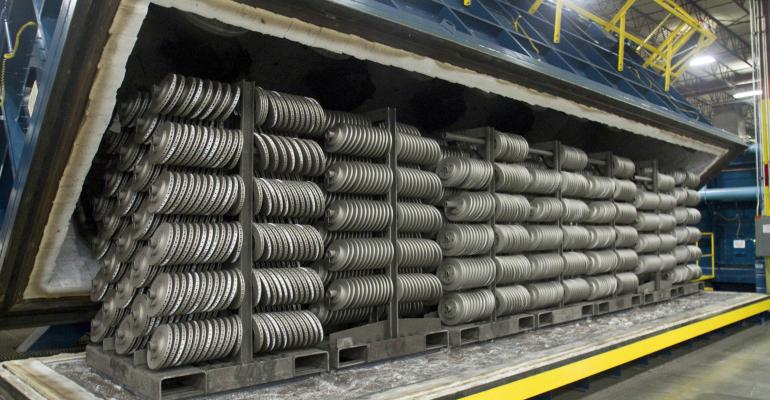WARREN, MI – General Motors develops a new heat-treatment process for its brake-system rotors that the auto maker expects will save customers’ money, reduce warranty costs and keep expensive wheels looking good.
Called Ferretic Nitro-Carburizing, the patented process cooks rotors at 1,040° F (560° C) for a day, bonding nitrogen atoms to the steel rotors to strengthen and harden them.
Since its introduction on a handful of models in 2008, the “rust-free rotors” have trimmed GM’s related warranty costs by 70%. The auto maker expects it to save customers $400 over a 10-year span by doubling the life of a rotor from 40,000 miles (64,000 km) to 80,000 miles (128,000 km).
The process keeps wheels looking good as well, says John Calabrese, vice president-global vehicle engineering at GM.
“You’ve got customers spending all kinds of money on these expensive wheels, sometimes $2,500 or more, and then there’s this rusty rotor behind it,” he tells journalists after a presentation at GM’s technical center here.
“It doesn’t look good, and it affects your customer satisfaction,” he says.
Rusty rotors not only look bad, Calabrese adds, but also affect the performance of the brakes by transmitting pulsations through the pedal.
Dealers dislike rotors not treated with the process because the rotors of an entire stock of vehicles can rust after just a light rain, creating what they call “lot rot.”
Brightening such an obscure part makes a big difference. GM research finds four in 10 owners list corrosion among their greatest vehicle pet peeves, and brake components rank among their top concerns.
Snow and road salt can create brake rust, as does the salty air vehicles face when being shipped around the world.
FNC also cuts down on brake dust, making wheels easier to clean.
The process, which adds a surface treatment of 10 microns to the rotor, about one-tenth the width of a human hair, will appear on 80% of GM’s U.S. vehicles by 2016. It now is featured on the Buick LaCrosse and Regal, as well as the Chevy Malibu, Impala and Volt.
Calabrese says the process costs more but claims customers will not see the premium reflected in the sticker price of GM vehicles. “There is an ‘on-cost’ to GM,” he says, declining to provide an exact dollar figure. “It’s manageable. But the important thing is, we saw the value to the consumer.
“There are things you do on behalf of the customer that should require a business case. This is not one of them.”
However, Calabrese still needed a business case to get FNC green-lighted, he admits. Previously cost-prohibitive, FNC now makes sense because of efforts by the auto maker to perfect the coating process now enabling the supply chain to deliver GM a consistent part, he says.
GM does not provide its rotor suppliers with the means to execute FNC, Calabrese says. Instead, the auto maker leaves it to the part maker to meet its requirements.





